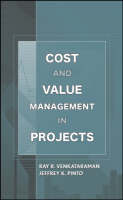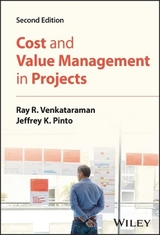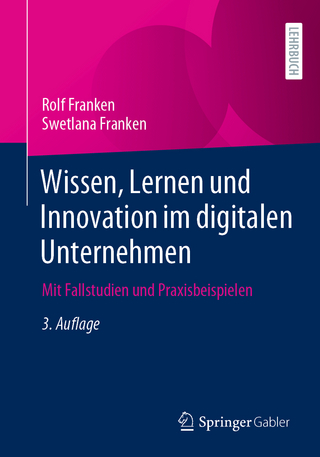
Cost and Value Management in Projects
John Wiley & Sons Inc (Verlag)
978-0-470-06913-4 (ISBN)
- Titel erscheint in neuer Auflage
- Artikel merken
Cost and Value Management in Projects provides practicing managers with a thorough understanding of the various dimensions of cost and value in projects, along with the factors that impact them, and the managerial approaches that would be most effective for achieving cost efficiency and value optimization. This book addresses cost from a strategic perspective, offering thorough coverage of the various elements of value management such as value planning, value engineering and value analysis from the perspective of projects.
Ray R. Venkataraman, PhD, is Associate Professor of Management at the Sam and Irene Black School of Business, Penn State Erie. He previously taught at DePaul University and Northern Illinois University, where he received the Ideal Industries Award for Excellence in Business Teaching. His scholarly articles have appeared in several top-tier journals. Jeffrey K. Pinto is Andrew Morrow and Elizabeth Lee Black Chair in Management of Technology in the Black School of Business, Penn State Erie. Professor Pinto is the coauthor, with Peter Morris, of The Wiley Guides to the Management of Projects series, as well as the author or editor of twenty other books and more than 100 scientific papers.
1 Introduction to the Challenge of Cost and Value Management in Projects 1
1.1 Importance of Cost and Value Management in Projects 2
1.2 Keys to Effective Project Cost Management 6
1.3 Essential Features of Project Value Management 8
1.4 Organization of the Book 9
References 14
2 Project Needs Assessment, Concept Development, and Planning 17
2.1 Needs Identification 19
2.2 Conceptual Development 22
2.3 The Statement of Work 23
2.4 Project Planning 27
2.5 Project Scope Definition 28
2.5.1 Purpose of the Scope Definition Document 29
2.5.2 Elements of the Scope Definition Document 29
2.5.3 Project Scope Changes 30
2.6 Work Breakdown Structure 32
2.6.1 Types of Work Breakdown Structures 34
2.6.2 Work Breakdown Structure Development 35
2.6.3 Coding of Work Breakdown Structures 38
2.6.4 Integrating the WBS and the Organization 38
2.6.5 Guidelines for Developing a Work Breakdown
Structure 42
References 42
3 Cost Estimation 43
3.1 Importance of Cost Estimation 44
3.2 Problems of Cost Estimation 45
3.3 Sources and Categories of Project Costs 49
3.4 Cost Estimating Methods 51
3.5 Cost Estimation Process 56
3.5.1 Creating the Detailed Estimate 56
3.6 Allowances for Contingencies in Cost Estimation 59
3.7 The Use of Learning Curves in Cost Estimation 61
References 64
Appendix 67
4 Project Budgeting 83
4.1 Issues in Project Budgeting 83
4.2 Developing a Project Budget 85
4.2.1 Issues in Creating a Project Budget 85
4.3 Approaches to Developing a Project Budget 85
4.3.1 Top-down Budgeting 86
Top-down Budgeting: Advantages 86
Top-down Budgeting: Disadvantages 87
4.3.2 Bottom-up Budgeting 88
Bottom-up Budgeting: Advantages 89
Bottom-up Budgeting: Disadvantages 90
4.4 Activity-based Costing 90
4.4.1 Steps in Activity-based Costing 90
4.4.2 Cost Drivers in Activity-based Costing 91
4.4.3 Sample Project Budget 1 91
4.4.4 Sample Project Budget 2 92
4.5 Program Budgeting 93
4.5.1 Time-phased Budgets 93
4.5.2 Tracking Chart 94
4.6 Developing a Project Contingency Budget 95
4.6.1 Allocation of Contingency Funds 95
4.6.2 Drawbacks of Contingency Funding 96
4.6.3 Advantages of Contingency Funding 97
4.7 Issues in Budget Development 98
4.8 Crashing the Project: Budget Effects 99
Crashing Project Activities—Decision Making 100
References 104
5 Project Cost Control 105
5.1 Overview of the Project Evaluation and Control System 105
5.1.1 Project Control Process 106
5.2 Integrating Cost and Time in Monitoring Project Performance: The S-Curve 107
5.3 Earned Value Management 111
5.4 Earned Value Management Model 112
5.5 Fundamentals of Earned Value 114
5.6 EVM Terminology 114
5.7 Relevancy of Earned Value Management 115
5.8 Conducting an Earned Value Analysis 117
5.9 Performing an Earned Value Assessment 119
5.10 Managing a Portfolio of Projects with Earned Value Management 122
5.11 Important Issues in the Effective Use of Earned Value Management 123
References 126
6 Cash Flow Management 127
6.1 The Concept of Cash Flow 127
6.2 Cash Flow and the Worth of Projects 131
6.2.1 The Time Value of Money, and Techniques for Determining It 132
6.2.2 Applying Discounting to Project Cash Flow 134
6.3 Payment Arrangements 137
6.3.1 Cost-reimbursable Arrangements 138
6.3.2 Payment Plans 140
6.3.3 Claims and Variations 142
6.3.4 Cost Variation Due to Inflation and Exchange Rate Fluctuation 144
6.3.5 Price Incentives 145
6.3.6 Retentions 146
References 148
7 Financial Management in Projects 149
7.1 Financing of Projects Versus Project Finance 149
7.2 Principles of Financing Projects 150
7.3 Types and Sources of Finance 151
7.4 Sources of Finance 153
7.5 Cost of Financing 153
7.6 Project Finance 154
7.7 The Process of Project Financial Management 156
7.7.1 Conducting Feasibility Studies 156
7.7.2 Planning the Project Finance 156
7.7.3 Arranging the Financial Package 157
7.7.4 Controlling the Financial Package 157
7.7.5 Controlling Financial Risk 158
7.7.6 Options Models 159
References 161
8 Value Management 163
8.1 Concept of Value 163
8.2 Dimensions and Measures of Value 166
8.3 Overview of Value Management 167
8.3.1 Definition 168
8.3.2 Scope 168
8.3.3 Key Principles of VM 168
8.3.4 Key Attributes of VM 169
8.4 Value Management Terms 169
8.5 Need for Value Management in Projects 171
8.6 The Value Management Approach 171
8.6.1 Cross-functional Framework 172
8.6.2 Use of Functions 172
8.6.3 Structured Decision Process 172
8.7 The VM Process 173
8.8 Benefits of Value Management 175
8.9 Other VM Requirements 175
8.10 Value Management Reviews 176
8.11 Relationship between Project Value and Risk 180
8.12 Value Management as an Aid to Risk Assessment 181
8.13 An Example of How VM and Risk Management Interrelate 182
References 184
9 Change Control and Configuration Management 185
9.1 Causes of Changes 186
9.2 Influence of Changes 190
9.3 Configuration Management 191
9.4 Configuration Management Standards 192
9.5 The CM Process 193
9.6 Control of Changes 196
9.7 Change Control Procedure and Configuration Control 197
9.8 Responsibility for the Control of Changes 200
9.9 Crisis Management 201
9.10 An Example of Configuration Management 202
References 206
10 Supply Chain Management 209
10.1 What Is Supply Chain Management? 210
10.2 The Need to Manage Supply Chains 211
10.3 SCM Benefits 212
10.4 Critical Areas of SCM 213
10.4.1 Customers 213
10.4.2 Suppliers 213
10.4.3 Design and Operations 214
10.4.4 Logistics 214
10.4.5 Inventory 215
10.5 SCM Issues in Project Management 215
10.6 Value Drivers in Project Supply Chain Management 217
10.7 Optimizing Value in Project Supply Chains 220
10.7.1 Total Quality Management 220
10.7.2 Choosing the Right Supply Chain 221
10.8 Project Supply Chain Process Framework 221
10.8.1 Procurement 221
Supply Chain Relationships 223
Supplier Development 224
10.8.2 Conversion 224
10.8.3 Delivery 225
10.9 Integrating the Supply Chain 225
10.10 Performance Metrics in Project Supply Chain Management 227
10.11 Project Supply Chain Metrics and the Supply Chain Operations Reference (SCOR) Model 230
10.12 Future Issues in Project Supply Chain Management 231
References 232
11 Quality Management in Projects 235
11.1 Definition of Quality in Projects 235
11.2 Elements of Project Quality 237
11.2.1 The Project’s Product 238
Quality Engineering 239
11.2.2 Management Processes 243
11.2.3 Quality Planning 243
11.2.4 Quality Assurance (QA) 244
11.2.5 Quality Control 245
11.2.6 Corporate Culture 245
11.3 Total Quality Management (TQM) in Projects 245
11.4 Quality Management Methods for a Project Organization 247
11.4.1 The Six Sigma Methodology 249
11.4.2 The Six Sigma Model for Projects 250
11.4.3 Application of Six Sigma in Software Project Management 252
11.5 Quality Standards for Projects 252
References 253
12 Integrating Cost and Value in Projects 255
12.1 The Project Value Chain 255
12.2 Project Value Chain Analysis 257
12.3 Sources and Strategies for Integrating Cost and Value in Projects 259
12.3.1 The Project’s Inbound Supply Chain 260
12.3.2 Project Design 260
12.3.3 Project Development 265
12.3.4 Project Delivery/Implementation 267
Life-cycle Costing 268
12.3.5 Costs of Project Life Cycle Employing the LCC Model 271
12.4 Integrated Value and Risk Management 272
12.5 The Project Cost and Value Integration Process 274
References 277
Index 279
| Erscheint lt. Verlag | 15.4.2008 |
|---|---|
| Verlagsort | New York |
| Sprache | englisch |
| Maße | 163 x 241 mm |
| Gewicht | 540 g |
| Themenwelt | Wirtschaft ► Betriebswirtschaft / Management ► Unternehmensführung / Management |
| ISBN-10 | 0-470-06913-9 / 0470069139 |
| ISBN-13 | 978-0-470-06913-4 / 9780470069134 |
| Zustand | Neuware |
| Haben Sie eine Frage zum Produkt? |
aus dem Bereich



